The global cloud kitchen market is projected to increase from $44.9 billion in 2023 to $154.9 billion by 2035, with an 11% CAGR, driven by the growth of independent kitchens and shifting consumer demands. As a result, cloud kitchen app development is playing a crucial role in supporting this transformation. (Allied Market Research)
The food distribution market has exploded in recent years, and cloud kitchens – also known as ghost kitchens or virtual kitchens – are at the heart of this change. Traditional Kitchens are struggling to maintain their business, with the dominance of platforms such as Apps Like UberEats, Doordash, and Derveroo.
Cloud kitchen eliminates the requirement of a physical dine-in space, which cuts operating costs, maximising distribution efficiency. But here is the grip: the competition is fierce. Without a powerful cloud kitchen app, your business risk falls behind.
In the USA, UK and UAE, where food distribution services are booming, investing in cloud kitchen app development is not just an option – this is a requirement. Customers demand spontaneous orders, real-time tracking and personal recommendations. If your cloud kitchen lacks a strong mobile or web application, you are missing significant revenue opportunities.
Hard Reality: Can Your Cloud Kitchen Survive Without an App?
If you are still relying on third-party aggregators such as UberEats, then you are playing a dangerous game. Here’s why:
- High Commission fee: The delivery platforms charge up to 30% per order while eating in your margin.
- Customer data shortage: Without direct access to customer insight, you cannot personalize the offer or create loyalty.
- Limited Brand Control: You are just doing another listing on the crowded market, making it difficult to separate your brand.
A custom cloud kitchen app development gives you control over branding, customer experience and profitability. The sooner you invest in on-demand cloud kitchen app development, the faster you can scale your maximizing revenue.
What Are the Essential Features of a Cloud Kitchen App?
A powerful app for cloud kitchen is not just about taking orders – it is about providing an extraordinary customer experience, streamlining operations for restaurant owners and adapting efficiency for delivery partners. Here’s how to develop a Cloud Kitchen app to make it truly competitive:
For Customers: Order Experience
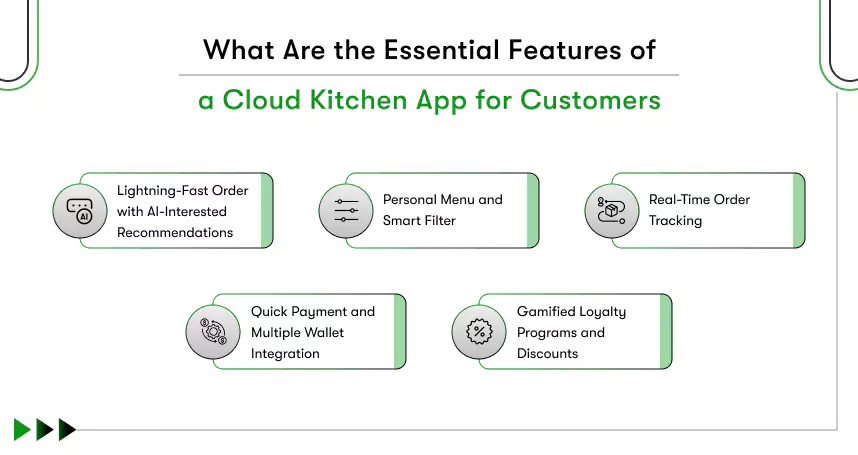
Lightning-Fast Order With AI-Interested Recommendations
Customers want their food fast, and they do not want to scroll through the menu. AI-driven suggestions based on previous orders, trending items and dietary preferences make the ordering process unique.
Personal Menu and Smart Filter
Gluten-free? Vegetarian? Keto? No problem. Tailoring the menu as per each customer’s dietary requirements makes an intelligent filtering system, ensuring that they find the right food in seconds.
Real-Time Order Tracking
No one likes to wait for his food. Live GPS tracking, automatic status updates, and exact delivery time estimate customers and reduce order-related anxiety.
Quick Payment and Multiple Wallet Integration
A friction-free checkout experience is essential for high conversion rates. The app should support all primary payment methods, including credit/debit cards, Apple Pay, Google Wallet, PayPal, and BNPL (now buy, pay later) options.
Gamified Loyalty Programs and Discounts
Do customers want to keep coming back? Offer loyalty points, exclusive discounts, and fun challenges that reward repeat orders. A well-designed gamification system increases engagement and customer retention.
For Restaurant Owners: Brain Behind Business
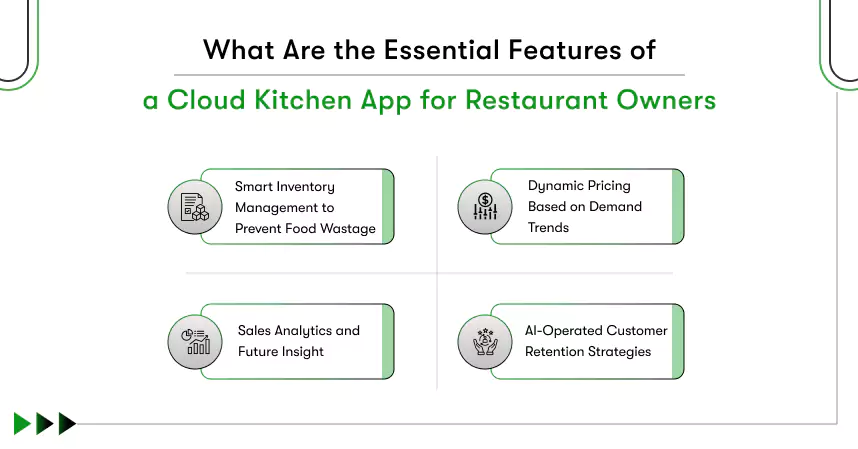
Smart Inventory Management to Prevent Food Wastage
Getting out of mid-services is a disaster. AI-inventory tracking ensures that stock levels are monitored in real-time, warning the kitchen staff before running the items.
Dynamic Pricing Based on Demand Trends
peak hours? Special events? The AI-powered automated pricing helps to maximise revenue by adjusting prices based on demand and ensures profitability without intimidating customers.
Sales Analytics and Future Insight
The Cloud Kitchen App should do more than the order of the process – it should help businesses grow. A powerful dashboard provides sales trends, peak-ordering time, customer behaviour insight and future revenue predictions.
AI-Operated Customer Retention Strategies
Personal discounts, re-involvement emails, and orders help to push information based on history to help customers return. AI-driven marketing equipment makes retention comfortable and practical.
For Delivery Partners: Because Speed Is Everything
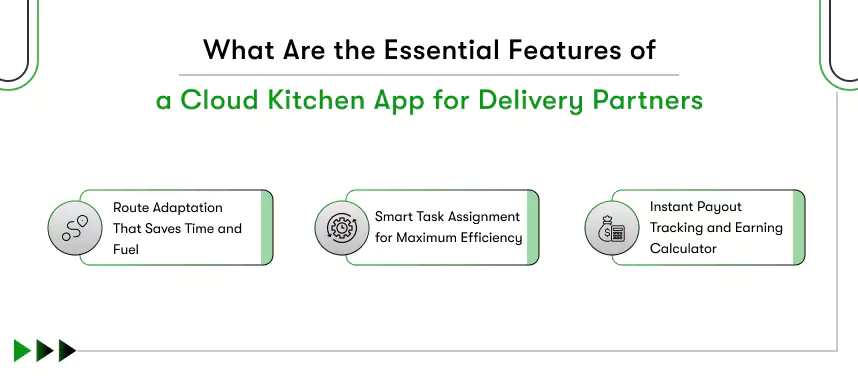
Route Adaptation That Saves Time and Fuel
Late delivery results in customer dissatisfaction. The AI based navigation makes sure that the driver take the best route, reducing delays and additionally reducing the cost of fuel.
Smart Task Assignment for Maximum Efficiency
Instead of manually assigning delivery, the app needs proximity, availability, and order priority for a smooth workflow for the delivery partners.
Instant Payout Tracking and Earning Calculator
Transparency matters. Drivers must have real-time access to their earnings, including complete delivery, tips and encouragement, making the fund easier to track and withdraw.
The Cloud Kitchen App Tech Stack: Build for Growth
The correct tech stack is the backbone of a successful cloud kitchen app. It ensures uninterrupted order management, inventory management and safe payment, and helps you to score easily. Here’s how to develop a Cloud Kitchen app using essential technologies:
1. Frontend: Spontaneous User Experience in devices
The front is the one that users see and interact with, from which it is one of the most critical components. A well-designed interface ensures customers can easily browse the menu, order, track delivery, and pay without frustration. Choosing a sharp, light and responsible front framework improves purpose and retention.
Recommendations:
• Construct a high-demonstration mobile app for both iOS and Android with React native / flutter-a single codebase.
• Vue.js / react.js – Create fast and interactive web apps with modern UI elements.
2. Backend: Real-time Operation Power Engine
Backend, external orders, managing accounts, and anything else connect real-time data synchronisation between restaurants, customers, and delivery partners. It needs to be high-performing, fast, and safe in terms of scale to be able to support thousands of orders placed in a day. A strong backend ensures spontaneous communication between various components of the app.
Best Options:
• Node.js- ideal for real-time applications, handling concurrent orders efficiently.
• Django (Python) – Perfect for Survivor and Scalable, AI-operated applications and automation.
3. Database: Management Order, Customer and Inventory
The app for cloud kitchen produces large-scale data, including order history, user preferences and kitchen inventory. A well-structured database must support high-speed transactions, accurate order tracking, and analytics to adapt to kitchen operations.
Recommendations:
• PostgreSQL / MySQL – They are ideal for data management, reporting, and analysis concerning the requirement of structured data support.
• MongoDB- Best NoSQL option for handling a lot of unstructured and frequently changing data with efficiency.
4. Cloud Hosting: Scalability & Performance Without Downtime
Your cloud kitchen application’s high reliability in performance must be borne by your hosting provider while also making it possible to endure those busy uptimes. Cloud hosting solutions automatically score your infrastructure based on demand, ensuring high availability and data protection by reducing server costs.
Best Options:
• AWS (Amazon Web Services) – Highly scalable and reliable for enterprises worldwide.
• Google Cloud Platform (GCP) – AI and ML friendly, great for predictive analytics.
5. AI and ML Integration: Freedom Automation and Personal Experience
AI/ML Development help optimize learning operations, improve order accuracy, personalize customer recommendations and predict demand trends. AI-operated chatbots also increase customer aid and reduce manual intervention.
Best Options:
• TensorFlow / PyTorch-AI-operated privatization and thoughtful recommendations.
• Google AutoML – Helps with demand forecast and automated inventory management.
6. Payment Gateway: Safe, fast and global transactions
A friction-free checkout experience reduces cart abandonment and increases sales. A safe payment gateway should support several payment methods, fraud detection and quick transactions while complying with financial rules like PCI-DSS.
Best Options
• Stripe / PayPal – safe, accepted globally, and easily integrated.
• Square offers the best, most simple, and most reliable payment processing for small businesses.
Choose the right tech stack, and you can develop a scalable, skilful application towards the future of cloud kitchens. Then, let’s estimate the food delivery app development cost for cloud kitchens, which requires budgeting hidden costs.
How Much Is Cloud Kitchen App Development Cost?
On-demand cloud kitchen app development cost varies depending on features, scalability and tech complexity. Here is the cloud kitchen app development cost estimate:
1. Basic MVP (Startup Model) – $ 20,000 to $ 40,000
- Essential features like order, payment, basic tracking.
- Small cloud kitchens or startups are ideal for testing the ideal market.
- Limited AI capabilities, basic UI.
Example Source: ClutchCo
2. Mid-ranging (AI-operated personalization)-$ 50,000 to $ 80,000
- Advanced AI- Customed recommendations and customer division.
- Real-Time Tracking, Multi-Brand Support, Loyalty Programs.
- Scalable backend with cloud hosting for future development.
Example Source: Goodfims
3. Enterprise -Grade (Scalable and fully automated) – $ 100,000+
- AI-Interested Demand Forecast, Automatic Inventory and Smart Pricing.
- Custom-made kitchen management system and delivery adaptation.
- Fuelled Admin Dashboard, Multi-Location Support.
Example Source: Appinvenivist

4. The hidden cost does not discuss anyone (but you should know!)
Even after the launch, the ongoing cost can affect your budget:
- Expect to spend 15-20% of the initial dev cost per year on maintenance and update-app updates, safety patches and feature improvement.
- API and third-party services – Google Maps API, payment gateway fees, and AI services can add up to $ 500- $ 5,000 per year based on use.
Marketing and User Acquisition – App launch promotion, impressive participation, and paid advertisements can cost $ 5,000+ monthly if you want rapid user growth.
DIY vs. Hiring a Cloud Kitchen App Development Company: Which One Wins?
You have two options when developing a cloud kitchen app: Create it yourself (DIY) or rent a professional food delivery app development company. DIY approach may be less costly but has few challenges. Let’s compare both options to determine which one is best suited for your business.
A. DIY Cloud Kitchen App Development
If you have an in-house tech team that knows how to develop a Cloud Kitchen app or you are empowered with low-code/no-code platforms, it would seem attractive to pick the DIY option for building a food delivery app solution. However, you should have thorough technical knowledge and experience to build the app.
Pros:
- Low upfront cost as you already have your in-house developers.
- Full control over features and functionality.
- Comparatively smooth process as you dont depend on the third party.
Cons:
- Long-term development timeline.
- You might have Limited scalability due to limited resources and no concrete plans for infrastructure.
- Security risk is there as DIY apps often lack advanced safety measures and compliance standards.
B. Cloud Kitchen App Development Company rental: smart options?
A professional food delivery app solution requires you to hire cloud kitchen app developers team who bring the ready-to-use framework and proven strategies to distribute the app ready for the market with low risks.
Pros:
- Bazaar from time to time with pre-made solutions and expertise.
- Scalable, safe and customised architecture for high-performing apps.
- Fluent maintenance, update and technical assistance.
Cons:
- Higher initial cloud kitchen app development cost.
- Proper hard work is required to choose the right development partner.
Bottom Line: If you want a fully functional, scalable and future-proof app, the best food delivery app developers are wise long-term investments. DIY is only viable for startups with in-house tech expertise.
The Biggest Cloud Kitchen App Development Mistakes (And How to Avoid Them)
Avaya has not developed a feasible system or strategy for generating stable revenue with an initially developed cloud kitchen project. Here are some common mistakes in cloud kitchen app development
1. Cloning Pre-Existing Food Delivery Applications:
People tend to mimic UberEats, DoorDash or Deliveroo in their attempts to enter the competitive food delivery field. But competition is not the problem; you will end up being lost in a myriad of very similar services.
Avoid This Mistake:
- Unique Selling Propositions-based such as offering some specific cuisine, AI personalization, or subscription meal plans.
- D2C model wherein consumers directly get their meals, escape third-party commissions.
2. User experience- Customers Uninstall in a Blink of an Eye:
An app that requires slow navigation, complicated processes for check-out, or the absence of real-time tracking completely disgusts users and escalates the uninstall rates.
Avoid This Mistake:
- The ordering flow should be as simple and minimalistic as possible; ensure that there are no hassles.
- One-click reorders, real-time order tracking and instant payments should be able to work.
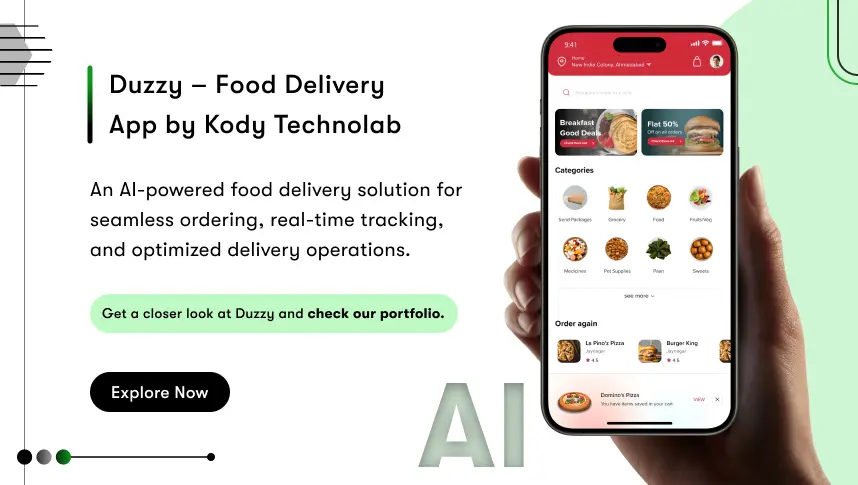
3. Poor backend infrastructure (high order volume cannot handle)
If your app crashes during peak hours, you will lose customers and reliability. A weak backend means slow performance, unsuccessful transactions, and delayed orders.
Avoid this mistake:
- Use Scalable Cloud Hosting (AWS, Google Cloud) to handle high traffic.
- Custom your database with high-speed cashing and load-balanced.
4. No AI-operated engagement strategy (losing repeat customers is expensive)
Getting new customers is more expensive than maintaining existing people, yet many cloud kitchen apps lack individual recommendations and loyalty programs such as AI-operated retention strategies.
Avoid this mistake:
- Apply AI-Operated Push Notification for Re-Connection.
Offer gamified rewards and personal discounts to promote loyalty.
The Step-by-Step Cloud Kitchen App Development Process
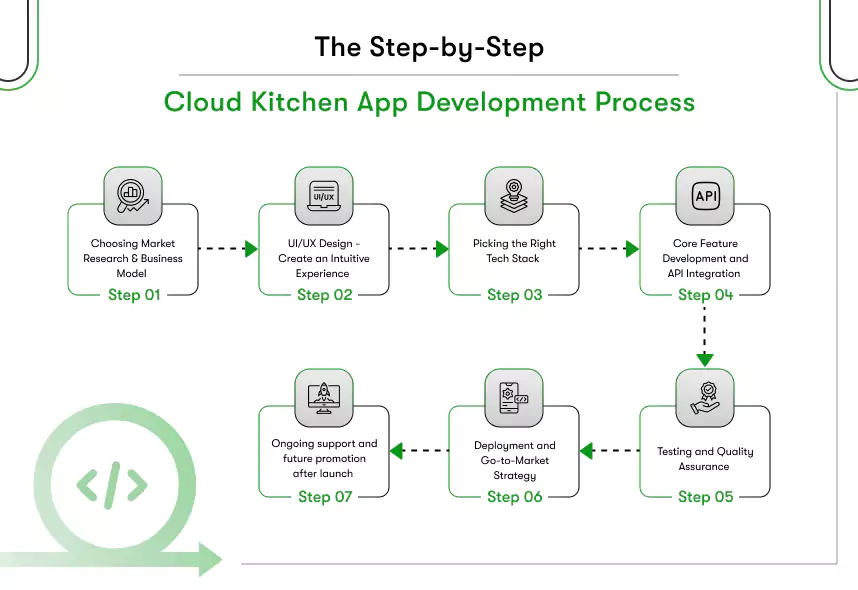
Creating an app for cloud kitchen involves a series of systematic steps that need to be completed properly so that they can be scalable and efficient and result in an excellent user experience. Each stage is essential in developing a high-performing application that can potentially handle a very high order volume, a spontaneous customer can provide travel, and can grow with function. Here is the complete breakdown of how to develop a Cloud Kitchen app.
Step 1: Choosing Market Research and Business Model
Do market research before starting the development process and determine your business model. The cloud kitchen sector is very competitive, and to differentiate from others, a unique business value should be defined. Researching competitors for food delivery app like jahez, UberEats and DoorDash can give you great insights into understanding gaps in the market and fine-tuning your model.
Key areas:
- Identify your target audience and their ordering preferences.
- Decide whether you should build a single-brand cloud kitchen or a multi-brand virtual restaurant.
- Decide whether to build your own delivery fleet or whether third-party services will suffice.
- Decide on the monetisation model (i.e., whether it will be based on subscription, commission, or direct ordering).
Step 2: UI/UX Design – Create an Intuitive Experience
A good user interface (UI) and user experience (UX) are the first of successful ingredients in a cloud kitchen app. Complicated designs and cluttered interfaces allow users to bath and take a decided turn from the website easily. The design of ordering as simple and intuitive as possible is the target.
Best Practices for UI/UX Design:
- Highly minimalist yet eye-catching interface.
- One-touch reordering and custom recommendations for loyal clients.
- Real-time tracking plus an interactive progress map.
- Fast and responsive across any device (iOS, Android, Web).
Step 3: Picking the Right Tech Stack
The technology stack you put in place will define the value of performance, scalability, and security of the application. Your backend must drive busy orders in real-time without delay or downtime under kitchen management and payment processing.
Recommended Tech Stack:
- Frontend: React Native / Flutter (for mobile apps), Vue.js / React.js (for web).
- Backend: Node.js (real-time efficiency), Django (secure and scalable).
- Database: PostgreSQL / MongoDB for fast order processing.
- Cloud Hosting: AWS / Google Cloud for high uptime and scalability.
Step 4: Core Feature Development and API Integration
This next stage includes the development of the main functionality of the Cloud Kitchen App. This is very important because the app should be used by many kinds of users – customers, restaurant owners, and delivery partners should all interface with the system.
Major features to include:
- Customer App: Easy menu navigation, AI-powered recommendations, real-time tracking.
- Restaurant Dashboard: Kitchen Management, Order Priority, Inventory Tracking.
- Delivery Partner App: Route Optimization, Earning Dashboard, Real-Time Task Assignment.
- Third-side integration: Google Maps API (for delivery tracking), Stripe/PayPal for safe payments, AI chatbots for customer support.
Step 5: Quality and Functionality Test
Before launching, the app needs to be thoroughly checked to ensure smooth performance, safety and user-friendly experience. Leaving this step can lead to glitter, slow performance or security weaknesses, which can hurt your reputation.
- Check every single function to ensure that they work correctly.
- Simulate high-order versions to check accidents or recession to test the perfomance.
- Safety Testing: Protect user data and ensure PCI-DSS compliance for payment.
- Various Tests: Gather feedback from beta users and refine UI/UX based on real-world interaction.
Step 6: Deployment and Go-to-Market Strategy
After the test, the application will be ready to upload on the app store (iOS) and Google Play (Android). A smooth launch requires a marketing strategy to further download additional downloads and engagement.
Major focus area for deployment and marketing:
- SEO-friendly details and optimise your app store listing with high-quality visuals.
- Pre-Launch Marketing Campaign included impressive participation and advertisement.
- Discounts and Offers, such as free delivery for users for the first time.
- Monitor real-time performance metrics and solve the bug after the immediate launch.
Step 7: Ongoing support and future promotion after launch
This is only the beginning when an app is launched. The cloud kitchen app requires continuous maintenance and updates of its new features based on consumer response and current market trends in food delivery apps.
Major post-Launch Strategies:
- Use AI-powered Upgrade to personalise apps and customer interactions.
- New facility implementation. For example, add some membership food plans or offer drone food distribution.
- App Performance Monitoring with Optimization Load Time, Safety and Promotion.
Customer loyalty program, push notification and exclusive offer.
The Future App for Cloud Kitchen: What’s Next in 2025 & Beyond?
- Today, the cloud kitchen industry is rapidly revolutionising with artificial intelligence, automation, and blockchain-altered operations and customer experiences. In 2025 and beyond, AI in Food Delivery App will enhance food suggestions, re-ordering, price approaches and rate discounts to drive retention.
- Automated and robotic operations will be integrated into kitchens for more accessible operations and better efficiency reduction in food waste. Robotic chefs, for instance, smart inventory tracking and IoT-connected appliances, make these advances all very promising. Blockchain, meanwhile, will manage inbuilt innovations for ensuring food traceability for transparency in sourcing, storing, and preparing food.
- Drone and autonomous vehicle deliveries will replace traditional delivery methods, reducing costs and increasing speed. Subscription meal plans, in addition, are expected to become increasingly popular, as they are tailored to trends in AI-based advising for personalising consumption to enable retention over the long haul.
For a cloud kitchen business to get an edge, all these must be integrated into the operation and new technology brought into the facility. An expert cloud kitchen app development company might help you ensure that the application becomes future-ready and readily scalable.

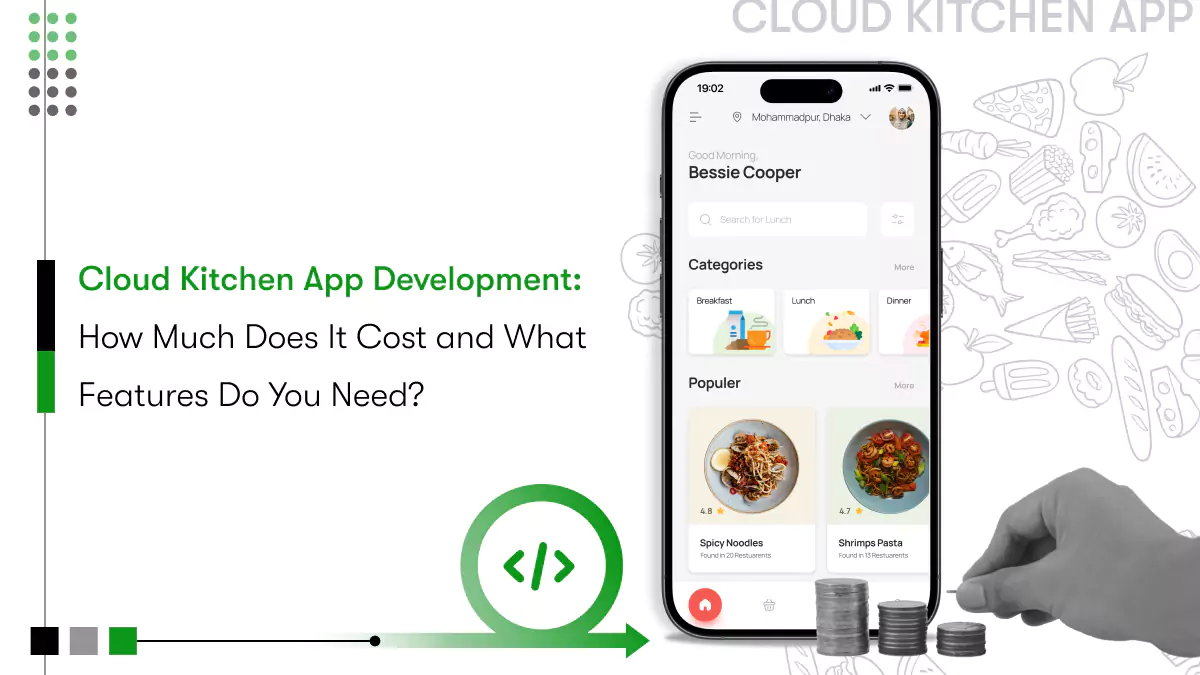

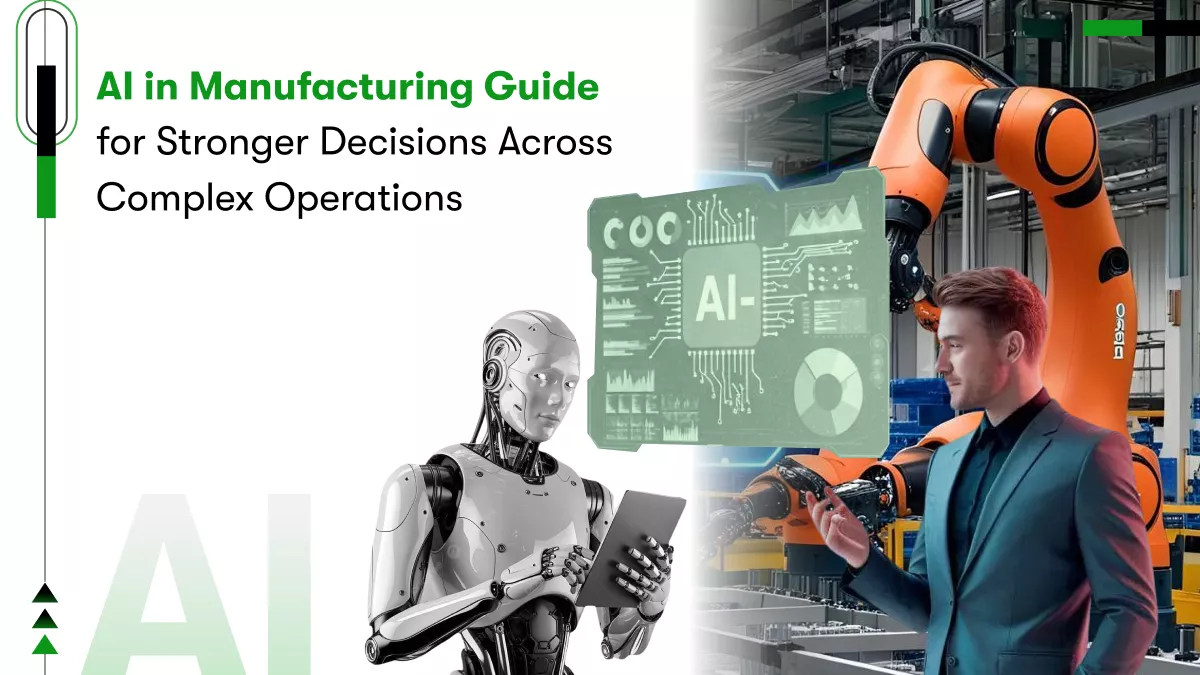
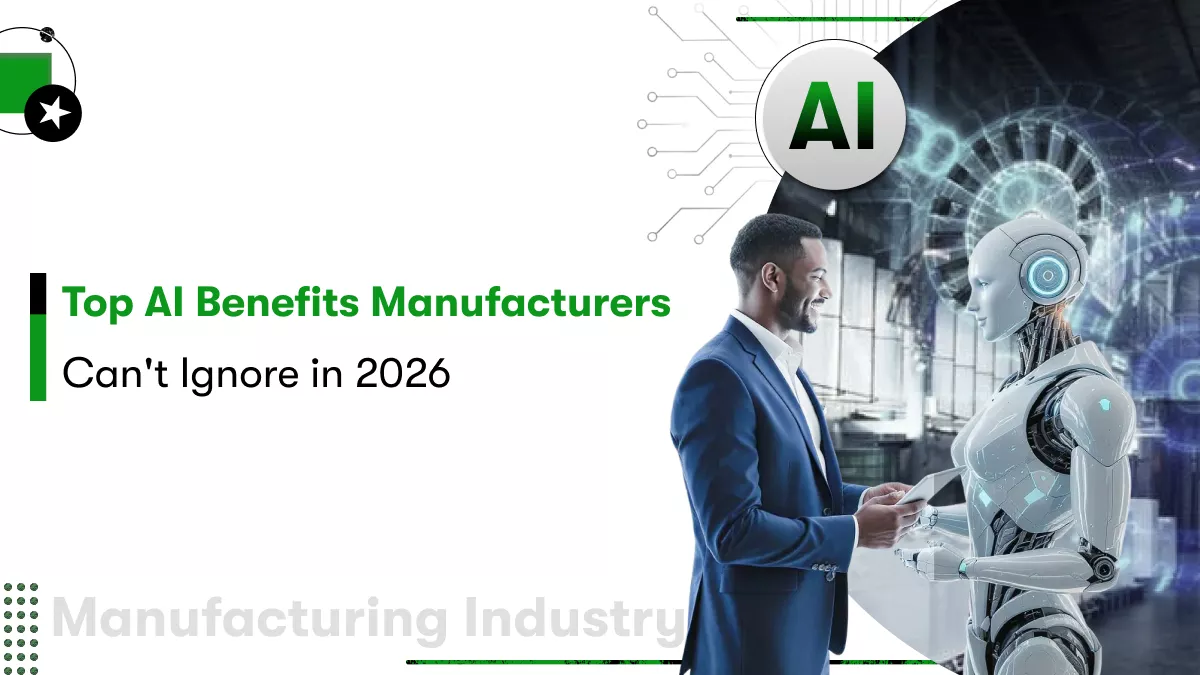
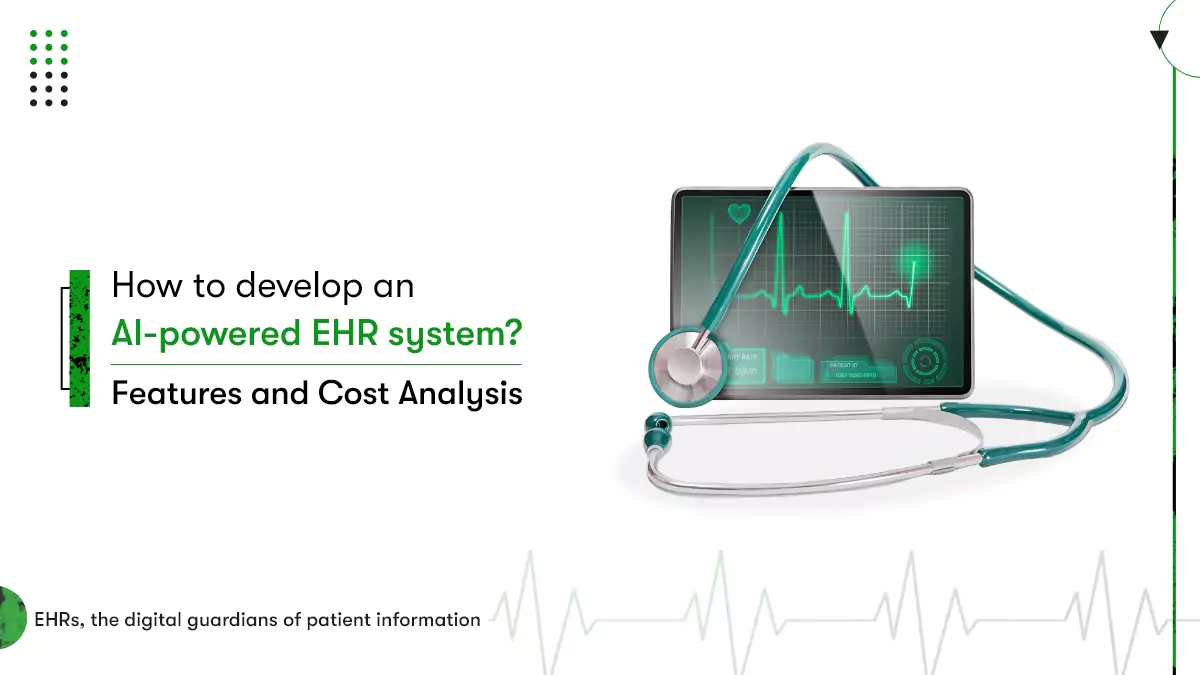


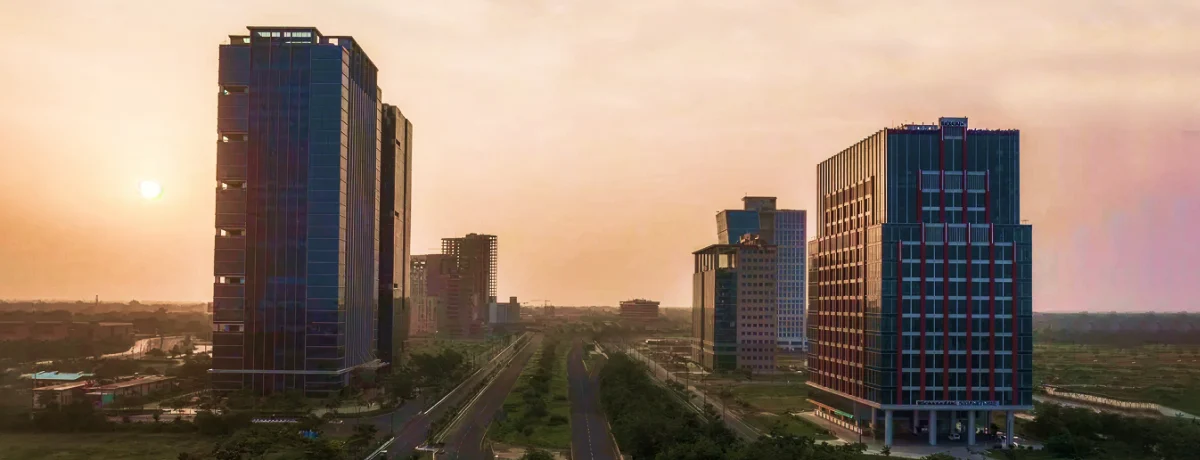




 Contact Information
Contact Information